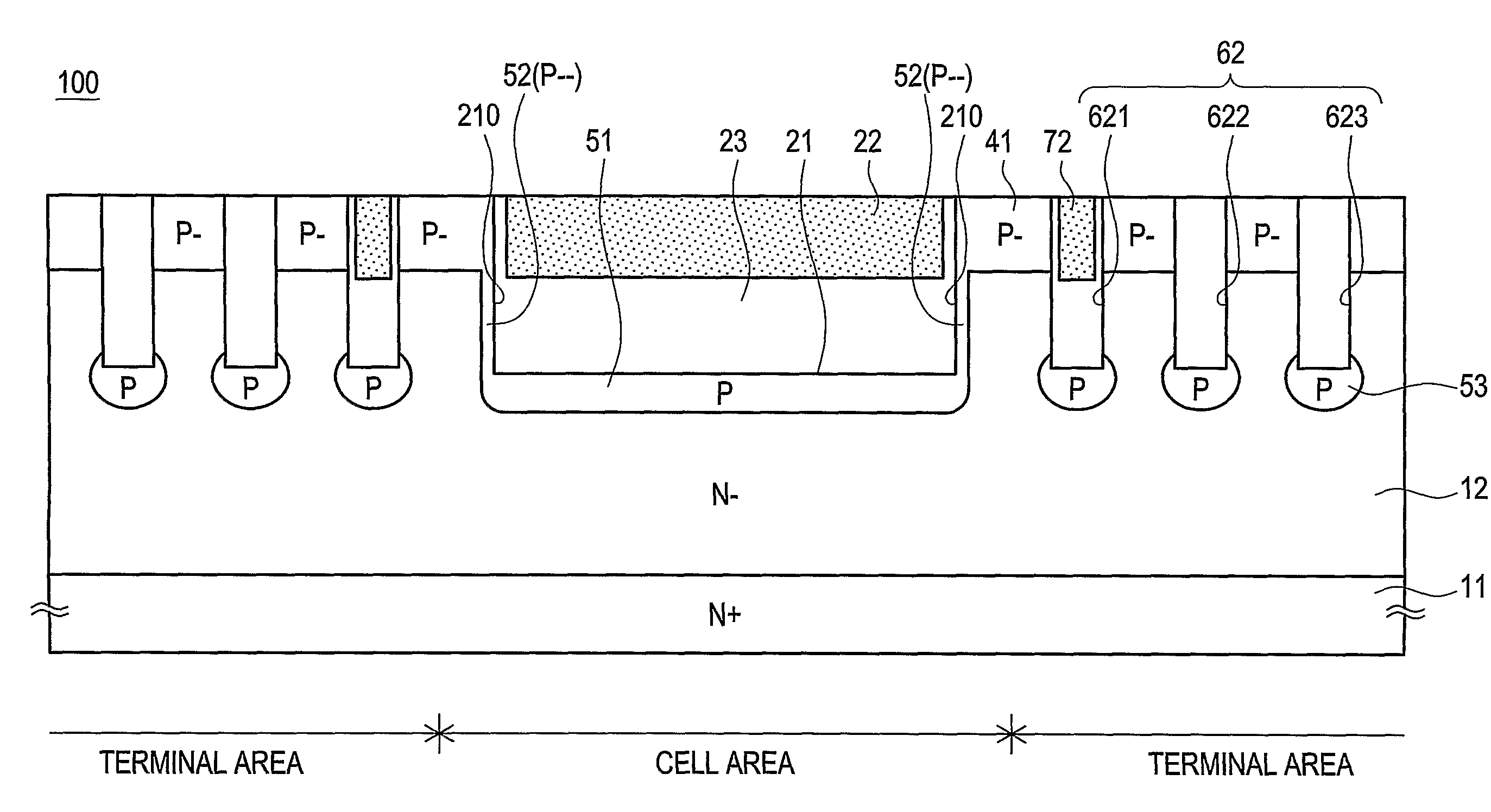Insulated gate-type semiconductor device having a low concentration diffusion region
a technology of diffusion region and semiconductor device, which is applied in the direction of semiconductor device, basic electric element, electrical apparatus, etc., can solve the problems of delay in supply of holes, low on-resistance state, and large quantity of holes to be supplied, so as to achieve the effect of reducing the withstand voltage and good on-resistance characteristics
- Summary
- Abstract
- Description
- Claims
- Application Information
AI Technical Summary
Benefits of technology
Problems solved by technology
Method used
Image
Examples
first embodiment
[0054]An insulated gate-type semiconductor device 100 (hereinafter referred to as “semiconductor device 100”) according to the first embodiment has such a structure as shown in the plan perspective view of FIG. 1 and the sectional view of FIG. 2. It will be noted that in the present specification, an entirety, in combination, of a starting substrate and a single crystal silicon portion formed by epitaxial growth on the starting substrate is called semiconductor substrate.
[0055]The semiconductor device 100 of this embodiment is constituted of a cell area (an area within a broken line frame x in FIG. 1) and a terminal area (an area outside of the broken line frame x in FIG. 1) surrounding the cell area. More particularly, the cell area of the semiconductor device 100 is partitioned with a terminal area. A plurality of gate trenches 21 are provided within the cell area and three terminal trenches 62 are provided within the terminal area.
[0056]Particularly, the gate trenches 21 and the ...
second embodiment
[0093]As shown in FIG. 9, a semiconductor device 200 of the second embodiment is formed with gate trenches 21 that have such a layout as to be divided into three groups in a lengthwise direction. With the semiconductor device 200, the gate trenches 21 are arranged to have a layout of being divided into a plurality of sub-trenches, so that the number of end portions 210 is larger than in the first embodiment. That is, the end portions 210 are two in number on the lengthwise direction in the first embodiment and are six in number on the lengthwise direction in this embodiment.
[0094]As shown in FIG. 10, a P−− diffusion region 52 surrounded with an N− drift region 12 is formed around the end portion 210 of individual sub-trenches. Like the first embodiment, the P−− diffusion region 52 is in connection with a P− body region 41 at an upper end thereof and also with a P diffusion region 51 at a lower end thereof. That is, the P−− diffusion region 52 serves as a supply path of holes.
[0095]T...
third embodiment
[0101]As shown in FIG. 14, a semiconductor device 300 of the third embodiment is formed with a P−− diffusion region 54 surrounded by an N− drift region 12 around one side surface of a gate trench 21. The P−− diffusion region 54 is in connection with a P− body region 41 at an upper end thereof and also with a P diffusion region 51 at a lower end, like the first embodiment. That is, the P−− diffusion region 54 serves as a hole supply path. The semiconductor device 300 of this embodiment differs from that of the first embodiment in that the hole supply path is whichever of the side surface portion and the end portion of the gate trench 21. It is to be noted that the position of the P−− diffusion region 54 may be at the side surface of the left side or the right side of the gate trench 21.
[0102]With the semiconductor device 300 of this embodiment, since the P−− diffusion region 54 serving as a hole supply path is formed on the side surface of the gate trench 21, it is easy to manufactur...
PUM
 Login to View More
Login to View More Abstract
Description
Claims
Application Information
 Login to View More
Login to View More - R&D
- Intellectual Property
- Life Sciences
- Materials
- Tech Scout
- Unparalleled Data Quality
- Higher Quality Content
- 60% Fewer Hallucinations
Browse by: Latest US Patents, China's latest patents, Technical Efficacy Thesaurus, Application Domain, Technology Topic, Popular Technical Reports.
© 2025 PatSnap. All rights reserved.Legal|Privacy policy|Modern Slavery Act Transparency Statement|Sitemap|About US| Contact US: help@patsnap.com



